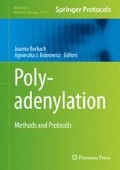Abstract
3′ end formation of eukaryotic messenger RNAs (mRNAs) is an essential process that influences mRNA stability, turnover, and translation. Polyadenylation is the process by which mRNAs are cleaved at specific sites in response to specific RNA sequence elements and binding of trans-acting protein factors; these cleaved mRNAs subsequently acquire non-templated poly(A) tails at their 3′ ends. Alternative polyadenylation occurs when multiple poly(A) signals are present in the primary mRNA transcript, in either the 3′ untranslated region (3′UTR) or other sites within the mRNA, resulting in multiple transcript variants of different lengths. We demonstrate here a new method, termed RHAPA (RNase H alternative polyadenylation assay), that employs conventional RT–PCR with gene-specific oligonucleotide hybridization and RNase H cleavage to directly measure and quantify alternatively polyadenylated transcripts. This method gives an absolute quantified expression level of each transcript variant and provides a way to examine poly(A) signal selection in different cell types and under different conditions. Ultimately, it can be used to further examine posttranscriptional regulation of gene expression.
Access this chapter
Tax calculation will be finalised at checkout
Purchases are for personal use only
References
Tian B, Hu J, Zhang H et al (2005) A large-scale analysis of mRNA polyadenylation of human and mouse genes. Nucleic Acids Res 33:201–212
Lutz CS, Moreira AM (2011) Alternative polyadenylation of eukaryotic mRNAs: an effective regulator of gene expression. WIREs RNA 2:22–31
di Giammartino DC, Nishida K, Manley JL (2011) Mechanisms and consequences of alternative polyadenylation. Mol Cell 43:853–866
Sandberg R, Neilson JR, Sarma A et al (2008) Proliferating cells express mRNAs with shortened 3′ untranslated regions and fewer microRNA target sites. Science 320:1643–1647
Mayr C, Bartel DP (2009) Widespread shortening of 3′ UTRs by alternative cleavage and polyadenylation activates oncogenes in cancer cells. Cell 138:673–684
Ji Z, Lee JY, Pan Z et al (2009) Progressive lengthening of 3′ untranslated regions of mRNAs by alternative polyadenylation during mouse embryonic development. Proc Natl Acad Sci U S A 106:7028–7033
Shi Y (2012) Alternative polyadenylation: new insights from global analyses. RNA 18:2105–2117
Acknowledgements
The authors wish to thank Anita Antes for careful reading of the manuscript. The authors also wish to thank the Lung Cancer Research Foundation and the American Heart Association, #12GRNT9120029 for grants awarded to C.S.L. Cheers to all.
Author information
Authors and Affiliations
Corresponding author
Editor information
Editors and Affiliations
Rights and permissions
Copyright information
© 2014 Springer Science+Business Media New York
About this protocol
Cite this protocol
Cornett, A.L., Lutz, C.S. (2014). RHAPA: A New Method to Quantify Alternative Polyadenylation. In: Rorbach, J., Bobrowicz, A. (eds) Polyadenylation. Methods in Molecular Biology, vol 1125. Humana Press, Totowa, NJ. https://doi.org/10.1007/978-1-62703-971-0_14
Download citation
DOI: https://doi.org/10.1007/978-1-62703-971-0_14
Published:
Publisher Name: Humana Press, Totowa, NJ
Print ISBN: 978-1-62703-970-3
Online ISBN: 978-1-62703-971-0
eBook Packages: Springer Protocols

